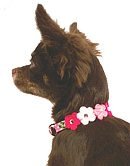Taking your Dog on a trip? Then read this first.
Tippy wants to say thank you for requesting this valuable info on how you
can safely have your dog travel with you on trips.
Use common sense, and above all else, make this a fun and enjoyable trip
for you and your precious dog.
One of the biggest problems we encounter is that folks tell us their pet
gets stressed out during or before trips, especially trips to the groomer
or vet.
All Natural and Very Effective at relieving tension and anxiety
in dogs and cats
We have the Perfect Solution to helping pets
Relax and be Calm
Check
out "Mellow Out" Pet Relaxant Here
Helpful hints and tips when taking your dog on
vacation
GET AN ID TAG
The very first rule of traveling with your pet is to have an ID tag or
other means of identification securely affixed to the dog. Thousands of dogs
end up in shelters simply because the owners never dreamed the dog would get
loose or become lost while on a trip.
There are few disasters in a person’s life that are worse than having to
drive off without a pet because every means of locating and recovery have
failed. This kind of tragedy will haunt you for the rest of your life; don’t
let it happen. Get an ID tag!
If Taking your Dog is not a Possibility
Before you leave make sure you consider the option of leaving your dog in a
hometown kennel. Most dogs love being in a kennel; there’s lots of activity,
they get special attention and in most cases consider a stay in the kennel
like we would a stay at the beach.
Visit the local kennel and see what goes on. Also there may be a Pet Sitter
in your area who would tend your pets in your own home. With a Pet Sitter you
can even call home and tell your dog how much fun you’re having... oh, yes,
and also how much you miss the rascal.

Getting Ready for the Trip
Make sure you know how your dog reacts to trips by taking a number of local
short trips, then if you need to take an “all-dayer” you’ll have a good
idea of what to expect. Any “all-dayer” is just a bunch of short trips
anyway. So, before you set off on that cross country trip be sure that you are
confident that you can predict how your dog will behave.
Motion Sickness
Vomit happens. Sometimes even humans get carsick. Most dogs can overcome
motion sickness through desensitizing them by using the same training
sequences of steps as described above in the puppy training.
Gradually accustom the dog to spending time in the car with the engine off,
then with the engine on, then short trips, then the cross-country adventure.
Prior to a trip be sure the dog has been fed at least three hours before you
set off.
You can also use anti-motion sickness medications to help settle the
stomach and prevent the sometimes prolific drooling that occurs in a nauseous
dog. Most medications are very safe antihistamines and many dogs eventually
can travel without the aid of medical assistance. Just in case, bring a roll
of paper towels.
- Note
- Motion sickness or hyperactivity? Here’s the difference… dogs with
motion sickness are generally quiet and even a little depressed because
they feel awful.
They will drool all over the place, maybe even pass stool, and eventually
start vomiting. Even with an empty stomach the vomiting reflex can be very
strong. These dogs will greatly benefit from anti-motion sickness medication
if it is given long enough in advance of the trip to be working before the dog
even suspects that a ride in the car is imminent.
The dog that goes bonkers when in a vehicle demonstrates hyperactivity.
These dogs aren’t sick, they’re possessed! Salivating, panting, whining,
jumping from front seat to back, barking at butterflies and trying to sit on
the steering wheel are common characteristics of the hyperactive canine
traveler.
If you must bring the hyperactive dog with you, medication to sedate the
dog will surely make the trip safer, easier and less stressful for both the
dog and the human.

This Dog's Hyper
What do you do with the dog that simply cannot control itself once that
engine starts and the wheels begin to roll?
If you have really tried to train the dog to do as it is told but the
motion and noise of traveling are simply overpowering and turn your dog into a
slathering, panting, barking demonstration of a Tae Bo exercise, there’s
hope!
Call your veterinarian and describe the demonstration. Then request
medication that will “take the Tae out of the Bo”. There are a number of
safe medications that will allow your dog to travel without all that stress,
noise and confusion. It will be a safer trip for both of you, not to mention
less stressful.
The key to successful use of pretrip medication is to administer it well
before the trip starts. Some dogs start their Tae Bo routine as soon as they
HEAR the word car! Be nonchalant, sneak a little medication in a treat, and don’t
mention the c a r anywhere near the dog prior to your trip. If you believe
your dogmay be a candidate for medication, be sure to do a leisurely pretrip trial
well ahead of the time you REALLY need it. About one dog out of ten will not
respond well to a particular medication or a particular dose.
You do not want to find this out the morning of an eight-hour, midwinter
trip through the Rockies to accept that national writing award you won for the
article on "Logical Steps To Effective Planning".
ATTENTION!
Yours should always be on the traffic, not on the dog. If your traveling
pal is a little dog, they usually will curl up next to you on the seat and
catch up on some sleep.
Do not ever allow them to go near the driver side floor where the brake and
gas pedals are located.
Big dogs may be best situated in the back seat and then you can legally
refer to the dog as your navigator. If you choose not to use a seat restraint
a gate type barrier between the front and the back seats is a good idea to
prevent an unexpected visit from your traveling companion.

Travel Crates
These inventions are very handy. Your dog, if happy and comfortable in a
crate, will be safer and you will have the peace of mind knowing it is secure
when you must leave your dog alone for short periods.
If you do use a crate, be certain that the dog is totally accustomed to it
well prior to the trip.
Visit our Pet Supply Shop for a wide assortment of crates, leashes,
collars and traveling accessories for dogs
*
Pet Shop Quality Dog
Supplies
*
Pet Shop Quality Cat
Supplies
Plan Ahead
Plan ahead… well ahead. If you know you will be staying overnight
somewhere, be sure to have reservations at an establishment that welcomes
pets. A handy list of “Pet Friendly” motels/hotels can be found if you do a little searching..
Don’t even think about it if you hope to hide your dog in your room or
think you will launch a successful appeal to the motel owner’s sense of
sympathy if you show up with an unannounced Great Pyrenees.
And don't forget to bring along some disposable "Scoop n Toss
Bags"; you must be socially conscious about where your dog chooses to
relieve itself. Be prepared!
Rest Areas
Make your timetable consistent with occasional stops along a side road
where your leashed dog can find relief. Many veterinarians do not think the
Rest Stations along the Interstates are a particularly sanitary area for your
dog. Not that you have to be fussy but why not select an area that avoids
conditions where dozens of dogs have already baptized the environment?
And be sure to have some “Pooper Pick-Ups” with you so that in the
event of an unexpected deposit in a public area, you can perform the courteous
cleanup immediately.
Food and Water
It wouldn’t hurt to pamper your pal… bring along your dog’s own food
and water from home and you will be better off. Not that you’re fussy,
right?
And a few old towels or rags will make good cleanup devices if the dog
happens to discover a mud puddle or contacts something nasty like spilled ice
cream sundaes! Emergency first aid kits are very handy for you and the dog if
a sudden cut, sliver or rash intrudes upon your day. Anti-itch medication,
bandages, and antibiotic ointments may save the day when you least expect
something will go wrong. It is a good idea to have your veterinarian give you
a copy of the dog’s medical history to take with you just in case a visit to
a veterinarian along the way becomes necessary.

Leashes
Here’s a safety tip… Bring two leashes. That way you’ll have a spare
when you misplace one. Your dog MUST be on a leash whenever you are in
unfamiliar surroundings.
All it takes is a split second for a disaster to start its fateful chain of
events. There are hundreds of reasons why your dog has to be on a leash
whenever you are not in your own back yard.
Heat Stroke
Leaving a dog alone in a car has a number of potential risks. Always be
conscious of the effects of heat buildup in a parked car. It only takes a few
minutes for the internal heat to build up forty degrees above the outside air
temperature especially if direct sunlight bakes the car.
Even the dog’s body heat (expired air in the dog’s breath is 102
degrees!) will act like a heater inside the car. Leaving windows open slightly
at the top surely helps IF there is a breeze. However, that opening also
invites children to poke their fingers in or unkind folks to tease the dog
with sticks.
Be very cautious about leaving dogs unattended in parked cars.
Heat stroke is a dire emergency and one from which many pets do not
recover. And you'd be shocked to find out just how fast it can occur.
If you ever find your pet distressed from overheating in a vehicle, get to
the nearest animal hospital immediately... don't even call first; just GO!
For minor mishaps, having a First Aid Kit on hand for your journey may be
your wisest investment. And keep the phone number of your veterinarian
accessible just in case you need to refill a lost prescription or need quick
advice. Sadly, many pets are harmed every summer by inattention to the very
real dangers of heat stroke.
Have Fun
Don’t forget to bring along some fun toys and tasty treats. These will
keep the dog contented for hours while you enjoy your trip. And bring the
camera!
How you can Lengthen your Dog's Life